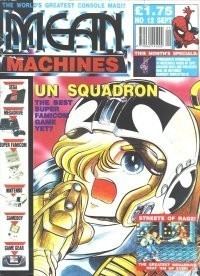Frequency Monthly Final issue— Number September 199224 | Categories Video game magazines First issue October 1990 Company EMAP | |
 | ||
Mean Machines was a multi-format gaming magazine released between 1990 and 1992 in the United Kingdom.
Contents
Origins
In the late 1980s Computer and Video Games (CVG) was largely covering the outgoing generation of 8-bit computers like the Commodore 64, ZX Spectrum, Amstrad CPC and newly emerging 16-bit computers (the Atari ST and Commodore Amiga). Julian Rignall built and launched a consoles-oriented section of the magazine called Mean Machines. The inaugural section was featured in the October 1987 issue of the magazine and largely covered games on 8-bit games systems like the Nintendo Entertainment System and Sega's Master System. It included features on newly emerging Japanese-only videogame systems such as NEC's PC Engine.
Over the ensuing months, CVG increased its coverage of consoles and started off a 'Mean Machines Megaclub'. At the same time, a new import gaming marketplace started to emerge fuelled by gamers' demand for these new consoles. Small retailers in Britain began importing consoles and games directly from Japan, modified them for the UK market and sold them on.
Rignall and newly hired designer Gary Harrod spent two weeks planning the design, editorial tone and style, and published Mean Machines Issue Zero - a 16-page test version of the magazine that was used to elicit feedback from potential advertisers and readers. Only ten of these magazines were published, although a mini version was reprinted and given away free with Issue 15 of the magazine.
The first issue covered the Sega Mega Drive, Sega Master System, Nintendo Entertainment System, Game Boy and Amstrad GX4000 consoles. Within a few months the Amstrad was taken off the market due to poor sales, and the Super Nintendo Entertainment System replaced it in the magazine's focus, making MM a mainly Sega and Nintendo only magazine. Coverage was also given to other machines like the NeoGeo and PC Engine.
Following the lead of parent magazine CVG, Mean Machines covered both domestic and imported releases, meaning that the magazine could review titles that were months away from UK release. At the time, import gaming was more popular than it is now, as increased territory lockouts and swifter UK release dates have made import gaming a relatively niche market.
Mean Machines Sega and Nintendo Magazine System
ISSN 0967-9014 and ISSN 0965-4240
As the UK video games market grew and matured, Sega and Nintendo emerged as the two dominant manufacturers. EMAP split the magazine in two, creating Mean Machines Sega and the officially-endorsed Nintendo Magazine System.
After a successful launch, monthly sales of NMS dropped to a level just below the original Mean Machines at its peak, and the circulation of MMS began to decline, and at the end of 1993, EMAP Images launched the officially-endorsed Sega Magazine, which competed with sales of its own independent Sega publication.
The magazine was published until the introduction of 32-bit consoles, when it eventually was incorporated into Official Sega Saturn Magazine (along with EMAP's official Sega Magazine). Nintendo Magazine System became Nintendo Official Magazine ISSN 1466-1748, and continued until the official Nintendo licence was won by Future Publishing. The last Mean Machines magazine was Mean Machines PlayStation ISSN 1364-3746 and the original Mean Machines staff had long since moved on. This soon folded after the launch of Official PlayStation Magazine. Only six issues were released.
Staff
Julian Rignall (Editor), Gary Harrod (Designer), Richard Leadbetter (Staff Writer), Radion Automatic (Staff Writer), Oz Browne (Designer), Matt Regan (Staff Writer), Angus Swan (Staff Writer), Paul Glancey (Contributor), Rob Bright (Staff Writer)
